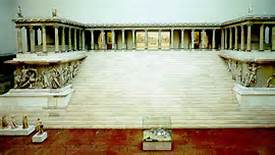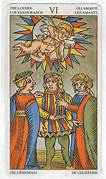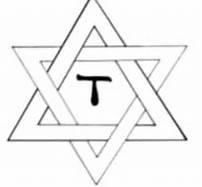 Arcanum VII is called The Chariot, or Curriculum Hermetis, meaning the Chariot of Hermes; Mouni Sadhu calls this trump The Conqueror. Prior to explaining this card, our author presents us with “the scheme of the first six arcana, which gives us the basis for the seventh, as the final link in the FIRST SEPTENARY of the Tarot.” This he summarizes as “Husband (1) fecundates the wife (2) resulting in the birth of the child (3) which, being fed and nursed physically and astrally (4) attains sufficient authority (4) to manifest itself on the astral plane (5) in the name of the whole family; but there meets with the dilemma of good and evil (6) chooses the GOOD and gains the victory (7). For the Seventh Arcanum means just that VICTORY.”
Arcanum VII is called The Chariot, or Curriculum Hermetis, meaning the Chariot of Hermes; Mouni Sadhu calls this trump The Conqueror. Prior to explaining this card, our author presents us with “the scheme of the first six arcana, which gives us the basis for the seventh, as the final link in the FIRST SEPTENARY of the Tarot.” This he summarizes as “Husband (1) fecundates the wife (2) resulting in the birth of the child (3) which, being fed and nursed physically and astrally (4) attains sufficient authority (4) to manifest itself on the astral plane (5) in the name of the whole family; but there meets with the dilemma of good and evil (6) chooses the GOOD and gains the victory (7). For the Seventh Arcanum means just that VICTORY.”
Mouni Sadhu presents us with an illustration of the Septenaries of the Tarot, showing three hexagrams with a center point. These Septenaries represent God, Man, and The Universe. On the first one, which we are concerned, the upper triangle has Spirit, Matter, Creation. And the Inverse triangle shows Will, Intelligence, and Beauty. The point is untitled, so I assume it is Victory.
In the Introduction of this book, our author displayed seven triangles representing the twenty-two arcana. This I proposed as “Swearing an oath in the name of Jehovah God”, the Tetragrammaton. Instead of forming groupings by 3, we have now formed three Hexagons. Since the hexagram equals six, the point representing seven is the Conqueror of the Hexagram. My thought is that this could, for example, represent the Chief Prince of Israel, which nation is represented by a hexagram on their flag. Of course, in the occult world, this chief prince is not Michael, who serves God. Michael has been assigned to the sixth arcana; not the seventh. A name is proposed in a later chart showing Anael, or Uriel, as the Conqueror of the Hexagram (Michael). But of course in the book of Revelation we see Michael and his angels casting Satan down from heaven to earth at some point in the future.
Mouni Sadhu further describes Arcanum VII as displaying a blue canopy, strewn with golden pentagrams. He says that these are the dwellers on the higher sub-planes of the astral world. “These pentagrams surpass the man by their powers, but also assist him, by giving their protection. The canopy is supported by four columns,” the Hermetic virtues of TO DARE, TO BE SILENT, TO KNOW, AND TO TRY.
Our Conqueror has armor which protects him from attack: three right angles. His armour is (1) correctness of his logic, (2) the arranging of his thoughts in a right form and (3) keenness and infallibility in physical realization. The chariot has aspects described by Ezekiel which involve the visions he saw of a moveable throne of God and the cherubims. Occult practitioners often interpret his vision as being the witness of the visit of a Mother Ship of alien gods.
Much of the commentary on Arcanum VII involves instruction in ceremonial magical rituals. We see that each Arcanum leads the magician further down into the depths of Satan. I would like to consider the Conqueror sitting in his chariot. Sisera, the Captain of the host of Jabin, was notable for his 900 chariots of iron. The LORD sold Israel into the hand of Jabin, king of Canaan, because of the evil they had done in the sight of the LORD. Judges 4 and 5 detail this history. Sisera, a military commander who has numerical associations with the number 666, and the priesthood of Lucifer, was not victorious in the end. Then we have that wicked King Ahab who was wounded and bled to death in his chariot.
In the Book of Revelation, notable for its repeat use of the number Seven, we find reference in chapter two to some group which has infiltrated both of the churches in Ephesus and Pergamos. This is the Nicolaitans, whose deeds and doctrine God says he hates. Nicolaitans means Conqueror of the People. In the case of Pergamos, we find a great temple described as “where Satan’s seat is”. While there are those in this church who honor God, Revelation 2:14-15 says this: “But I have a few things against thee, because thou hast there them that hold the doctrine of Balaam, who taught Balac to cast a stumbling block before the children of Israel, to eat things sacrificed unto idols, and to commit fornication. So hast thou also them that hold the doctrine of the Nicolaitans, which thing I hate. ”
Revelation 2:16 warns, Repent, or else I will come unto thee quickly, and will fight against them with the sword of my mouth.” Who is giving this warning? It is Jesus Christ who is the Victory, the Conqueror, who sits at the right hand of God.



